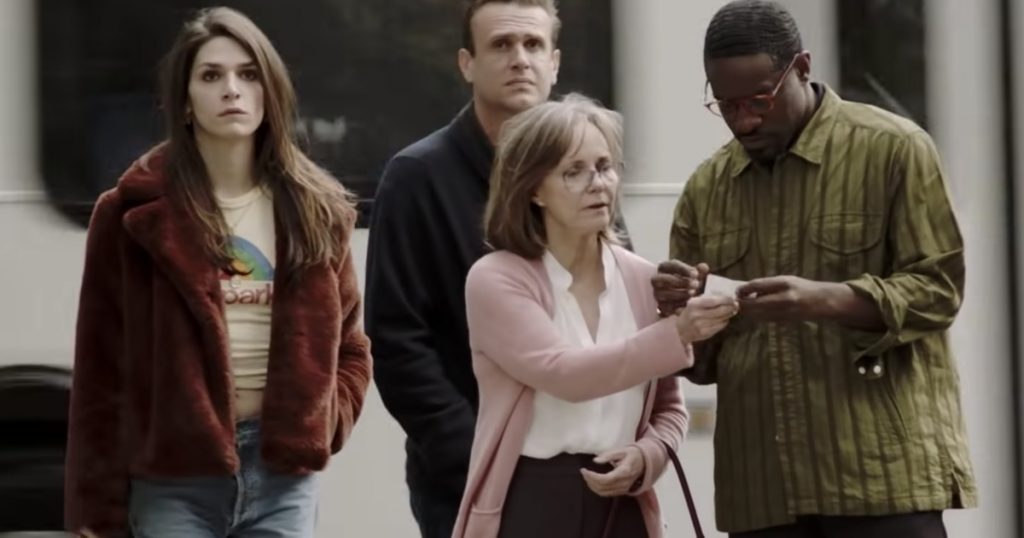
Now that the first season is over I thought I’d give a non-spoilery take on Dispatches From Elsewhere. There will be some mentions of the events in the first episode, so if you want to go in completely fresh go watch it first.
This won’t be your typical review, as I was a participant of the real life events this series was based on.
My ears perked up when this series was announced. The name comes from a pirate radio broadcast participants would listen to in Dolores Park which introduced the second chapter of Games of Nonchalance — which I’m just going to call The Jejune Institute here since that’s what most of us called it anyway.
I’ll admit upfront I’m not particularly familiar with Jason Segel (aside from that one Muppet movie) so I wasn’t too certain what to expect from a show he produced, wrote, and co-stars in. Personally I very much enjoyed the show’s first season, with its many twists and entirely unexpected ending.
Just like it’s “real” counterpart, in Dispatches From Elsewhere its version of The Jejune Institute presents itself as a mystery, becomes an act of escapism, and when it’s all over nothing’s really changed. Except of course for the things you decide to change yourself. And maybe the friends you make along the way.
Episode 1
So let’s go into the setup in the first episode before I get into how real life events were switched around into a television show.
The series opens with The Jejune Institute’s leader, Octavio Coleman, breaking the fourth wall and acknowledging you’re watching a TV show. He introduces Peter (Jason Segel), a bored employee at a music streaming company in Philadelphia.
Coming across a series of inexplicable flyers attached to utility poles with a phone number attached, Peter eventually pulls off a tab, calls the number, and finds he has an appointment at The Jejune Institute.
After an intense initiation — which drives Peter to tears — he disobeys Octavio and follows the directions on the initiation card. This leads him on a short journey where he meets another participant, Simone (Eve Lindley), a transgender woman who seems ready to attack him at first. Their meeting appears to have been intentional somehow, and they wind up becoming friends, solving some unmentioned piece of the game together.
Later on The Jejune Institute holds an event where, after dancing with a breakdancer and a sasquatch in the rain, participants are assigned into groups of four; Simone and Peter are put into a group of four along with Janice (Sally Field), an energetic older woman, and Fredwynn (Andre “3000” Benjamin), a strange man who alternates between a Sherlock Holmes-style detective and a nutty conspiracy theorist.
What makes the show compelling is how it follows this group of four participants as they go through an experience where they’re never certain exactly what’s part of the game and what’s not, let alone what the rules are — or if there are any.
The source material
So let’s talk about similarities and differences between the show and what I recall based on my experiences. Obviously the show is set in Philadelphia, but real life The Jejune Institute took place in San Francisco (though one chapter was in Oakland.) The flyers Peter finds look nearly identical to the ones I encountered in San Francisco’s SOMA neighborhood. The real Jejune Institute didn’t have appointments as far as I’m aware — it was a walk-in affair.
Many aspects from the show were taken from the real Jejune Institute including certain characters’ names, notably the names of Octavio Coleman and his enemy Commander 14. The mysterious promise “To those dark horses with the spirit to look up and see, a recondite family awaits,” also originated at the real Jejune Institute’s induction session.
Obviously some of the events in the show are dramatized quite a bit, though many have clear nods to the source material. The Jejune Institute didn’t have rules exactly, though there was a sort of winking aspect to it that let you know you were safe and on the right track.
More information about The Jejune Institute can be found at the official summary web page. Or in numerous blog entries right here on this very site.
The other source material
Segel’s inspiration for Dispatches From Elsewhere wasn’t actually The Jejune Institute itself, but rather the 2013 documentary The Institute. In the documentary participants and creators give talking head style monologues about The Jejune Institute, and we see footage (much of which was recorded by participants) about each of the four chapters and the silly after party.
Although I went to see The Institute at its premier I don’t think I’d seen it a second time — until Monday, when it was streamed on Twitch. The documentary’s director, Spencer McCall, and the creator of The Jejune Institute, Jeff Hull, were in the chat to answer questions and provide context.
I have to point out that one of the talking heads in the film, a very enthusiastic participant named Kiyomi Tanouye, was tragically a victim of the Ghost Ship fire in 2016. The first season of Dispatches From Elsewhere is dedicated to her memory.
The Institute is a much better documentary than I remember. It’s easy to see how Segel was influenced not only by the wild stories and events, but also people’s reactions. Oh and the part with dancing with a sasquatch and a breakdancer in the rain? Yup, that really happened — only to a select few, however. See the clip below for proof:
I’ll also admit the few glimpses of me in the movie make me question what was going on with my hair at the time. Too much mousse or something, it looked terrible. What was I thinking?
If you’d like to see The Institute yourself, it’s available for streaming on iTunes and Amazon Video.
